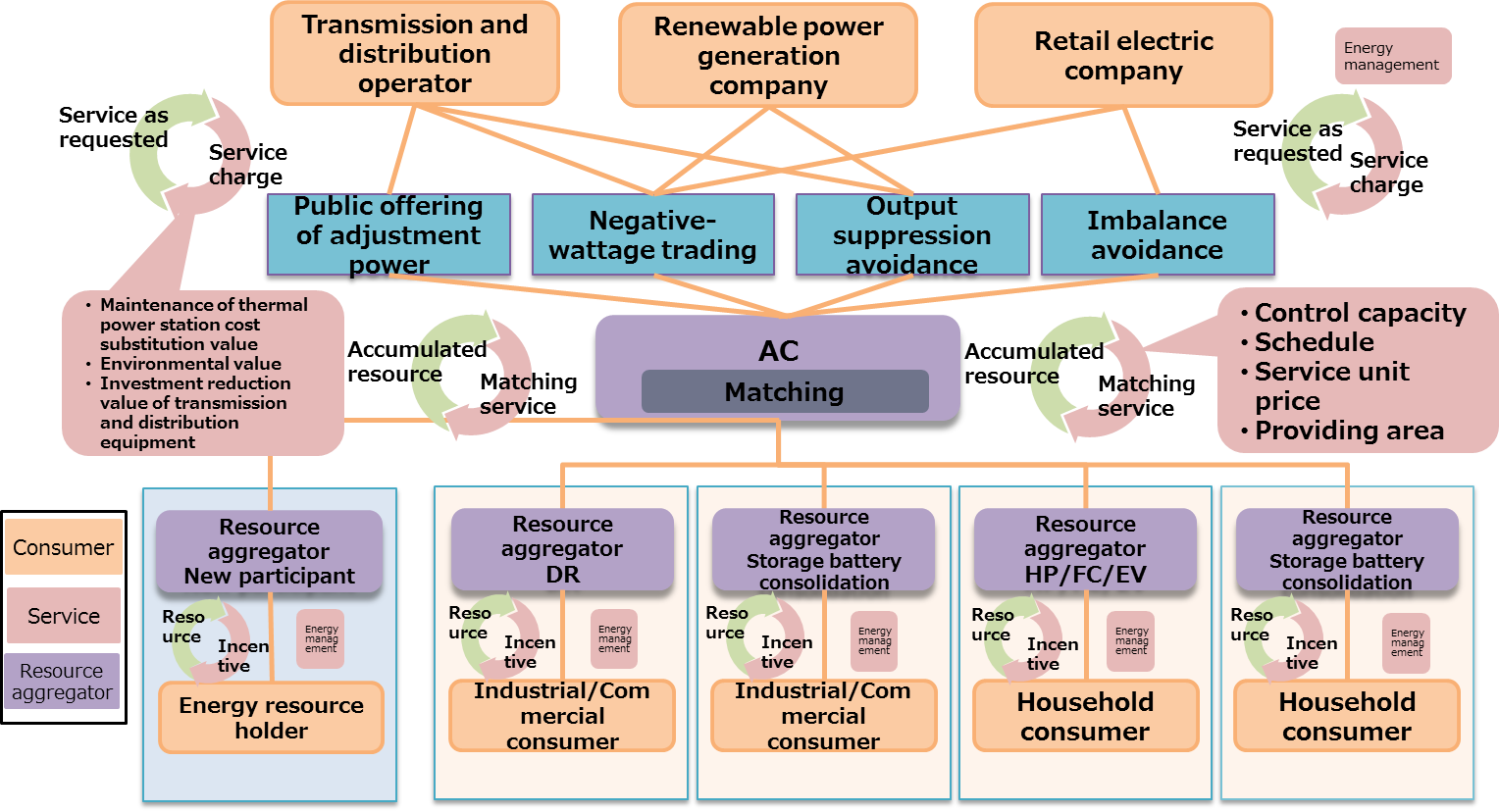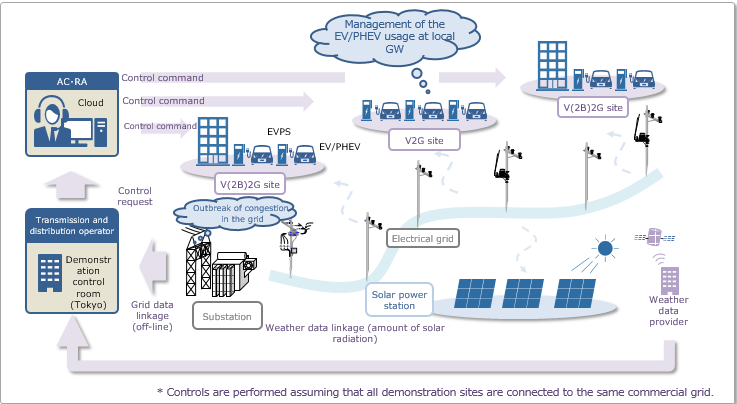Tokyo Electric Power Company Holdings, Inc.
NEC Corporation
Goal connect Co., Ltd.
SEKISUI CHEMICAL CO., LTD.
TEPCO Power Grid, Inc.
TEPCO Energy Partner, Inc.
TAKAOKA TOKO CO., LTD.
Toshiba Energy Systems & Solutions Corporation
Japan Weather Association
Mitsubishi Motors Corporation
Hitachi Systems Power Services, Ltd.
NEC Corporation
Goal connect Co., Ltd.
SEKISUI CHEMICAL CO., LTD.
TEPCO Power Grid, Inc.
TEPCO Energy Partner, Inc.
TAKAOKA TOKO CO., LTD.
Toshiba Energy Systems & Solutions Corporation
Japan Weather Association
Mitsubishi Motors Corporation
Hitachi Systems Power Services, Ltd.
Thirty companies including Tokyo Electric Power Company Holdings, Inc., NEC Corporation, Goal connect Co., Ltd., SEKISUI CHEMICAL CO., LTD., TEPCO Power Grid, Inc., TEPCO Energy Partner, Inc., TAKAOKA TOKO CO., LTD., Toshiba Energy Systems & Solutions Corporation, Japan Weather Association, Mitsubishi Motors Corporation, and Hitachi Systems Power Services, Ltd.*1 have applied as a consortium for a grant to cover the costs of its "FY2020 Demonstration Project for the Construction of a Virtual Power Plant that Utilizes Demand-Side Energy Resources (VPP Aggregation Project)," for which a public offering was made by the Ministry of Economy, Trade and Industry through its Sustainable Open Innovation Initiative. The demonstration phase of this experiment, which aims to construct a virtual power plant*2 (hereinafter referred to as, "VPP") through which resource aggregation can be commercialized, commenced today.
In recent years, problems that impact the stable operation of power grids, such as output fluctuations and surplus power generated by renewable energy sources (hereinafter referred to as, "RESs"), such as solar power, have continued to manifest. Adjustments at power stations and the other facilities are required to stabilize power grids, but owning and maintaining power generation equipment necessary to do so is costly. Amidst these conditions it is becoming necessary to develop a new mechanism that can balance the continual introduction of RESs with power grid stability at low-cost.
Through this demonstration project, these thirty companies aim to balance the continual expansion and introduction of RESs into the future with power grid stability, and construct a VPP that connects energy resources dispersed throughout society (multifarious power equipment, such as storage batteries, electric vehicles (hereinafter referred to as, "EV/PHEV"), water heaters, solar power generation and the other equipment) and can be used to adjust power supply on a megawatt scale. Furthermore, the project also aims to establish a business model for Vehicle to Grid (V2G) systems that can adjust power demand/supply through bidirectionality with EV/PHEV storage batteries.
In FY2016, we developed an Aggregation Coordinator*3 (hereinafter referred to as, "AC") system and secured resources. In FY2017, we improved and tested this AC system to fit the needs of power distribution and transmission companies, and created a business model for the commercialization of resource aggregation. Then in FY2018, we again improved and tested the AC system in anticipation of the future supply and demand adjustment market, and deliberated how to stabilize distribution networks.
In FY2019, 10 companies joined the project and we were able to continue to develop and expand resources while improving and testing the AC system to fit the needs of the supply/demand adjustment market.
In FY2020, we shall further improve and test this AC system in order to further improve resource control accuracy and accelerated our deliberation of supply/demand adjustment market system issues and business models. We shall also engage in initiatives that aim for the early start of our resource aggregation business and our entrance into the supply/demand adjustment market from FY2021.
Through the construction of a VPP, this consortium of thirty companies aims to establish an innovative energy management system and commercialize resource aggregation in order to solve global energy/environmental issues.
*1: Consortium members (thirty companies)
Aggregation Coordinators (three companies) (◎: Core company)
◎ Tokyo Electric Power Company Holdings, Inc. (Headquarters: Chiyoda-ku, Tokyo; President: Tomoaki Kobayakawa)
- NEC Corporation (Headquarters: Minato-ku, Tokyo; President and CEO: Takashi Niino)
- Goal connect Co.,Ltd. (Headquarters: Minato-ku, Tokyo; President : Akira Oshita)
Joint demonstration project (eight companies)
- SEKISUI CHEMICAL CO., LTD. (Headquarters: Osaka City, Osaka; President and Representative Director: Keita Kato)
- TEPCO Power Grid, Inc. (Headquarters: Chiyoda-ku, Tokyo; President: Yoshinori Kaneko)
- TEPCO Energy Partner, Inc. (Headquarters: Chuo-ku, Tokyo; President: Nobuhide Akimoto)
- TAKAOKA TOKO CO., LTD. (Headquarters: Koto-ku, Tokyo; President: Toshiro Takebe)
- Toshiba Energy Systems & Solutions Corporation (Headquarters: Kawasaki City, Kanagawa Prefecture; President and CEO: Mamoru Hatazawa)
- Japan Weather Association (Headquarters: Toshima-ku, Tokyo; Chairman: Ken Haruta)
- Mitsubishi Motors Corporation (Headquarters: Minato-ku, Tokyo; Representative Executive Officer, CEO: Takao Kato)
- Hitachi Systems Power Services, Ltd. (Headquarters: Minato-ku, Tokyo; President/CEO: Akira Sakai)
Resource aggregators (19 companies)
- Global Engineering Co., Ltd.
- ONE Energy Corporation
- Osaki Electric Co., Ltd.
- FAMILYNET JAPAN Corporation
- KYOCERA Corporation
- EFFICIENT Inc.
- MUL Utility Innovation Co., Ltd.
- Shizuoka Gas Co., Ltd.
- ELIIY Power Co., Ltd.
- Energy Optimizer Inc.
- KANDENKO Co., Ltd
- Nippon Koei Co., Ltd.
- SANIX Inc.
- Toyo Engineering Corporation
- Yachiyo Engineering Co., Ltd.
- Takenaka Corporation
- Tokyo Gas Co., Ltd.
- ENE -VISION Co., Ltd.
- Advantec Co., Ltd.
27 companies, with the exception of Toshiba Energy Systems & Solutions Corporation, Energy Optimizer Inc., and Advantec Co., Ltd., were selected and approved for subsidies. The aforementioned remaining three companies should be selected and approved for subsidies this month.
*2: Virtual Power Plant (VPP):
A virtual power plant that uses information and communications technology for the integrated control of dispersed energy resources and functions like a single power generation facility.
*3: Aggregation Coordinator (AC):
An aggregation coordinator aggregates multiple power loads controlled by resource aggregators, which control resources upon entering into VPP service agreements with demand households, and directly engages in power transactions with general transmission and distribution operators and retail electric companies.
Overview of Virtual Power Plant (VPP) Construction Demonstration Project
[Primary demonstrations to be conducted during FY2020]
<AC system improvements>
In light of the results of demonstrations conducted during FY2019 of the aggregation coordinator (AC) system that we developed in the same year, we have improved frequency (on the order of seconds) control function and other functions aimed at further improving control accuracy.
<Developing resources>
During this fiscal year a new resource aggregator (RA) has joined the project, and RA that have participated in the project since last fiscal year have continued to proactively develop resources.
<Technical demonstrations>
Common demonstrations shall be performed in light of the requirements of the supply/demand adjustment market.
https://sii.or.jp/vpp02/uploads/R2VPP_kyoutujishousiyou.pdf (only in Japanese)
<V2G business model deliberations>
Along with continuing deliberations on a V2G business model, we shall also deliberate how to advance V2G control in accordance with this V2G business model such as by deliberating methods for backing up sudden mobility needs (inter-site flexibility).
[Resource aggregation]
[V2G (concept diagram)]
<Reference>
Past Achievements of the Virtual Power Plant Construction Demonstration Project
1. FY2016 Primary Demonstrations and Results
<AC system development>
Requirements for an AC system were defined, and an AC system prototype was developed.
<Resource preparation>
Lithium ion batteries were newly introduced for household and industrial/commercial consumers (approx. 3.4 MWh). Furthermore, control units were installed for existing industrial/commercial consumer NAS batteries and a demonstration of demand response (DR) was conducted at 10 minutes, one hour, and four hours prior to use. As a result, we were able to verify high DR success rate at all times.
2. FY2017 Primary Demonstrations and Results
<AC system improvements>
Improvements were made to the prototype developed in FY2016 and an AC system that enables adjustment within 15 minutes and within five minutes of the command was constructed.
<Resource development>
In FY2017, three more RA joined the project, and RA that had been part of the project since FY2016 continue to proactively develop resources. Over 12.4 MW of resources were secured on a control capacity basis.
<Technical demonstrations>
In regards to technical demonstrations, we are able to control output on a megawatt level by accommodating approximately 7 MW of control commands, and our best control volume average deviation was 2%.
<Business model deliberations>
The feasibility of aggregation as a business (break-even point analysis) was examined, and under certain conditions we showed that several tens of megawatts of resources need to be leveraged in order to exceed the break-even point for any single fiscal year.
3. FY2018 Primary Demonstrations and Results
<AC system improvements>
The AC system developed in FY2017 was improved by adding control volume adjustment functions and market price-linked control functions.
<Resource development>
Eight new RA joined the program in FY2018, and RA that have been participating in the program since FY2017 continued to proactively develop resources.
<Technical demonstrations>
During technical demonstrations our best stay rate assessment (assessed by examining the percentage of time that actual control volume stayed within ±10% of control command values) for approximately 400kW of control command exceeded 75%.
Furthermore, we were able to develop a method for responding to control volume changes by combining resources that leverage the attributes of high-response storage batteries, and highly sustainable private power generators.
<Distribution grid stabilization>
The impact that the increased introduction of dispersed renewable energies has on distribution grids was assessed. And, we quantitatively ascertained the effect that control of consumer resources by RAs has on distribution grids.
<V2G technical demonstrations>
We constructed a demonstration environment for enabling bidirectional power connection between EV/PHEV and power grids, and confirmed its effectiveness for contributing to power grid stabilization.
4. FY2019 Primary Demonstrations and Results
<AC system improvements>
In light of FY2019 technical demonstrations, the AC system developed in FY2018 was additionally equipped with the ability to respond to one-minute command value changes, and baseline calculation method changes.
<Resource development>
Nine new RA joined the program in FY2019, and RA that have been participating in the program since FY2018 continued to proactively develop resources
<Technical demonstrations>
During technical demonstrations, our best achievement rate for approximately 7 MW of control command from tertiary adjustment ability② in the supply/demand adjustment market was 100% (6/6 periods).
<Distribution grid stabilization>
Technical issues and business models were deliberated upon compiling issues to address in order to stabilize grids and avoid the need for additional equipment by having RA control consumer resources.
<Advancing V2G control>
We created one of the Japan's largest demonstration environment through the addition of approximately 40 EV/PHEV (total number of vehicles: 59). Furthermore, in light of EV/PHEV mobility needs, we enabled EV/PHEV parked at the demonstration site to be controlled simultaneously via online systems.

